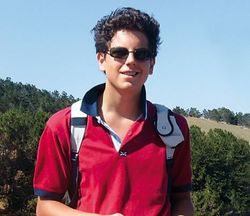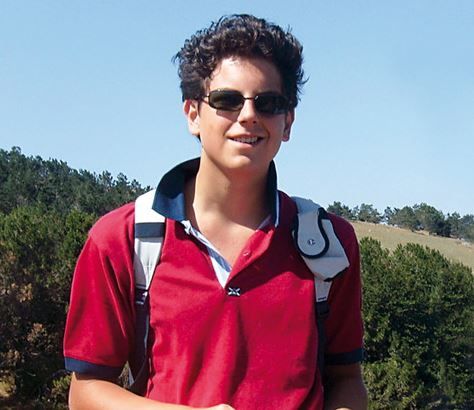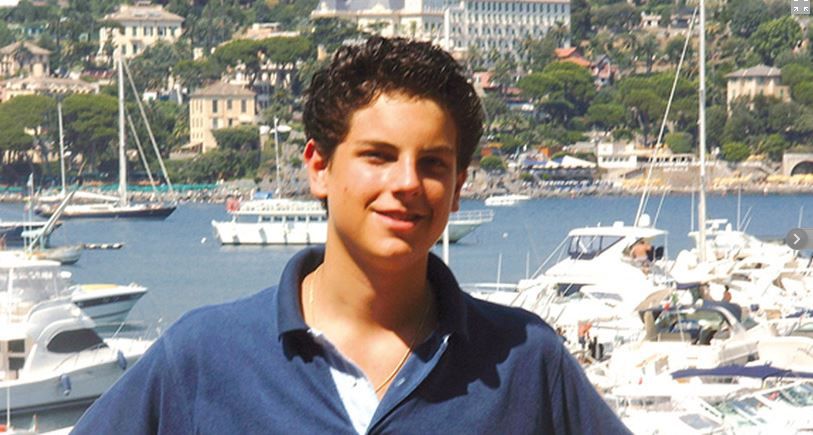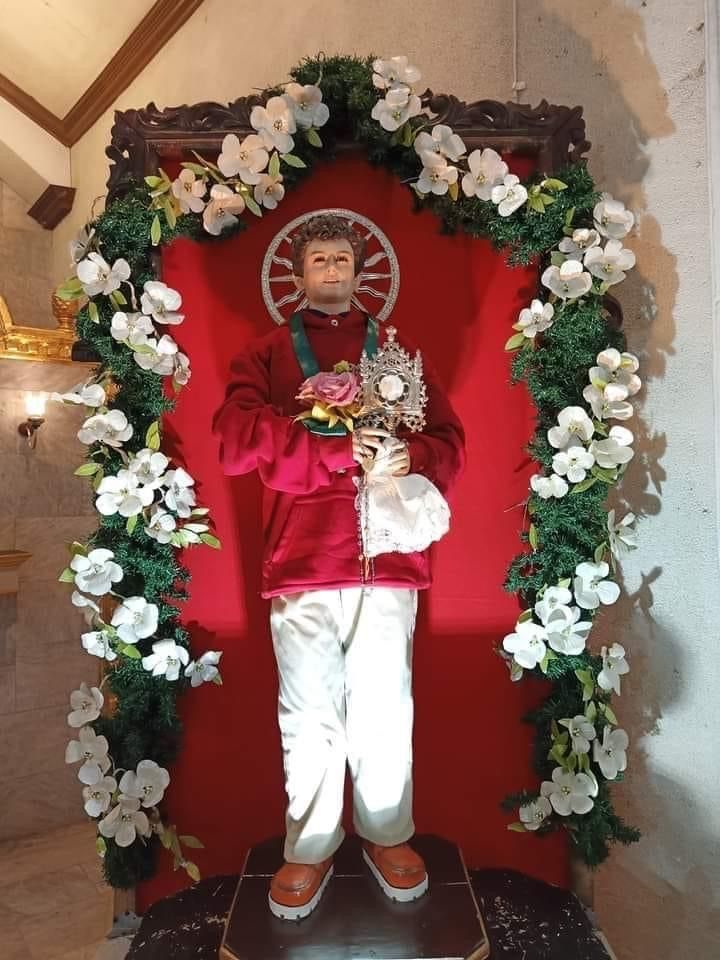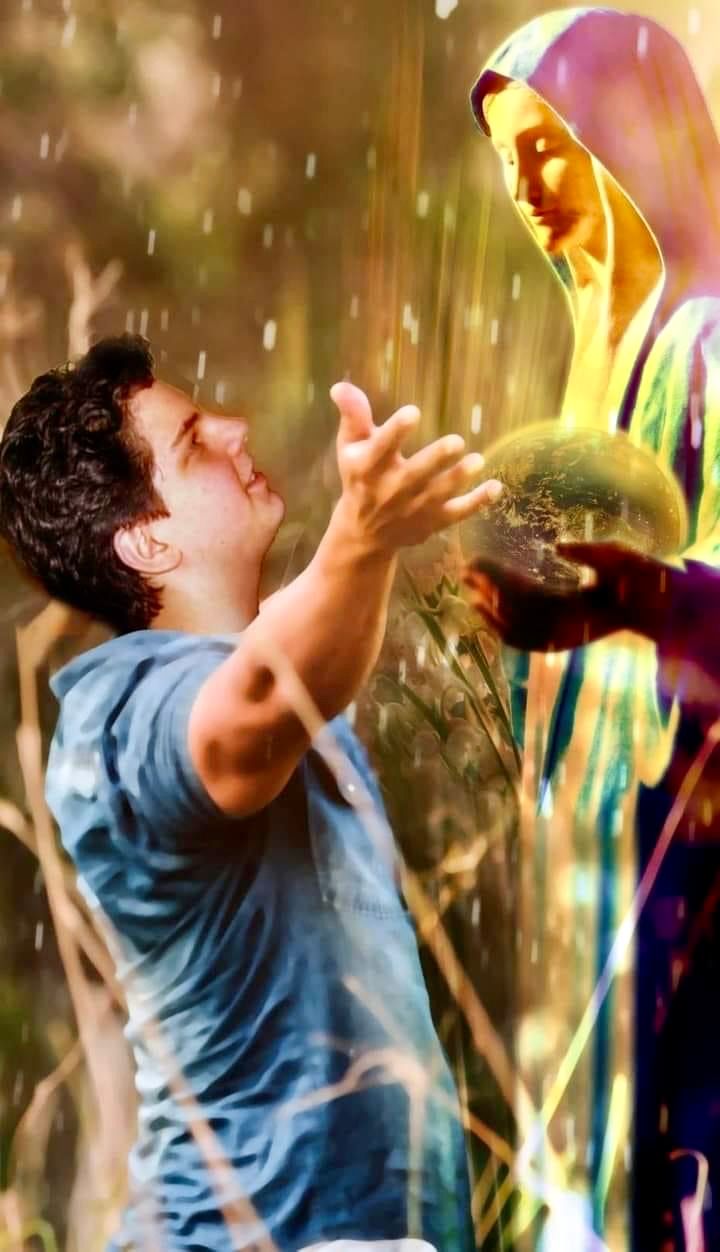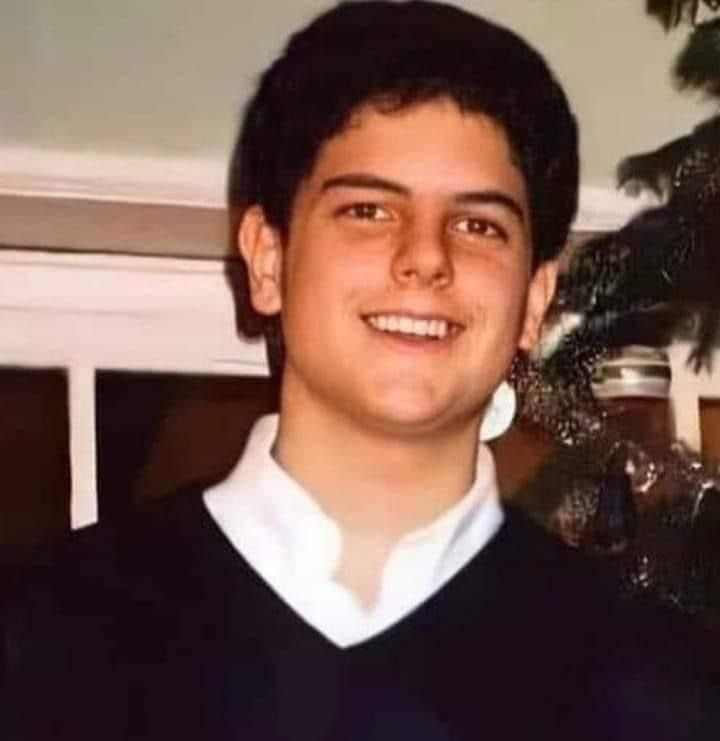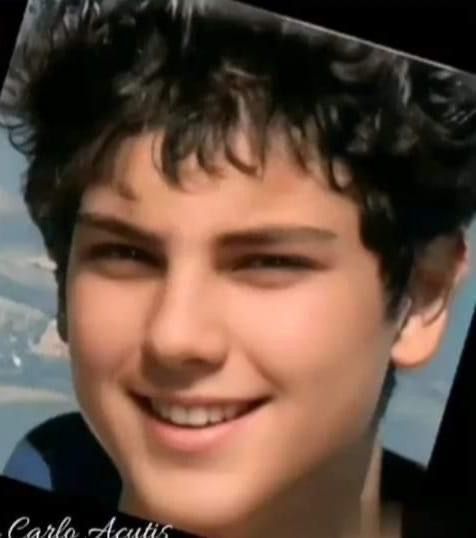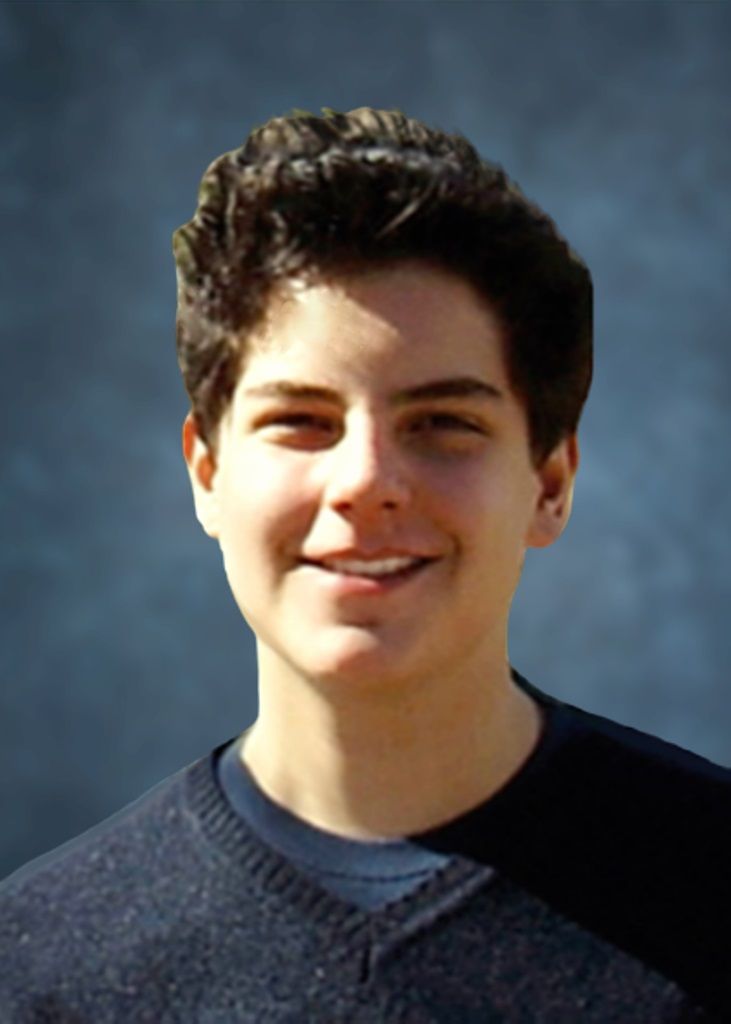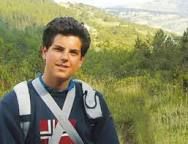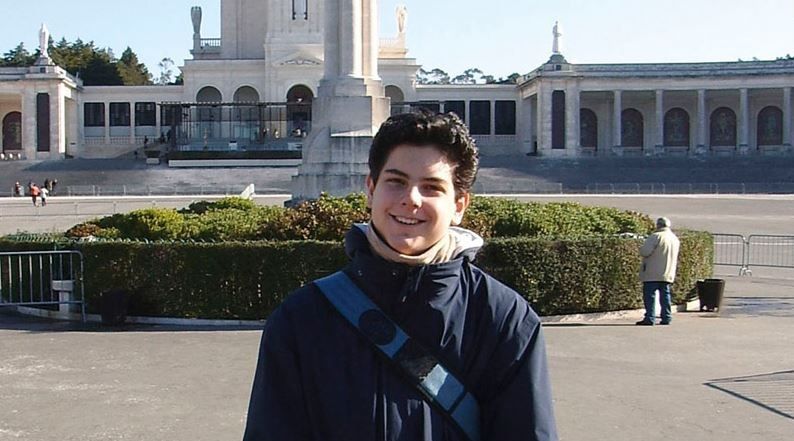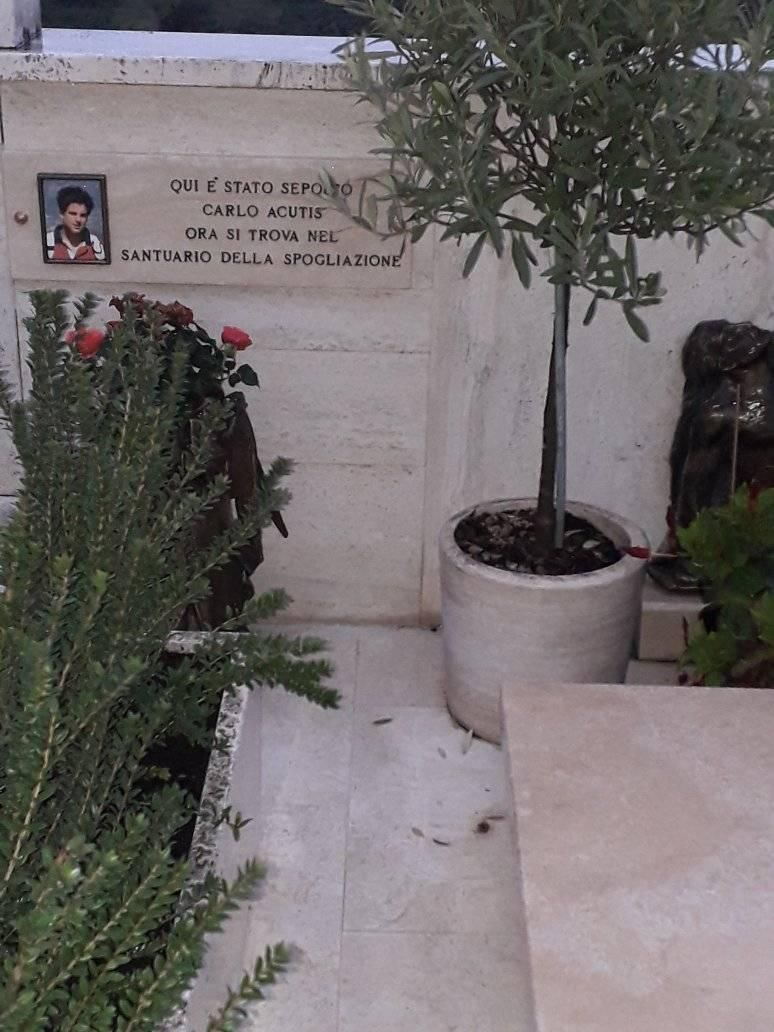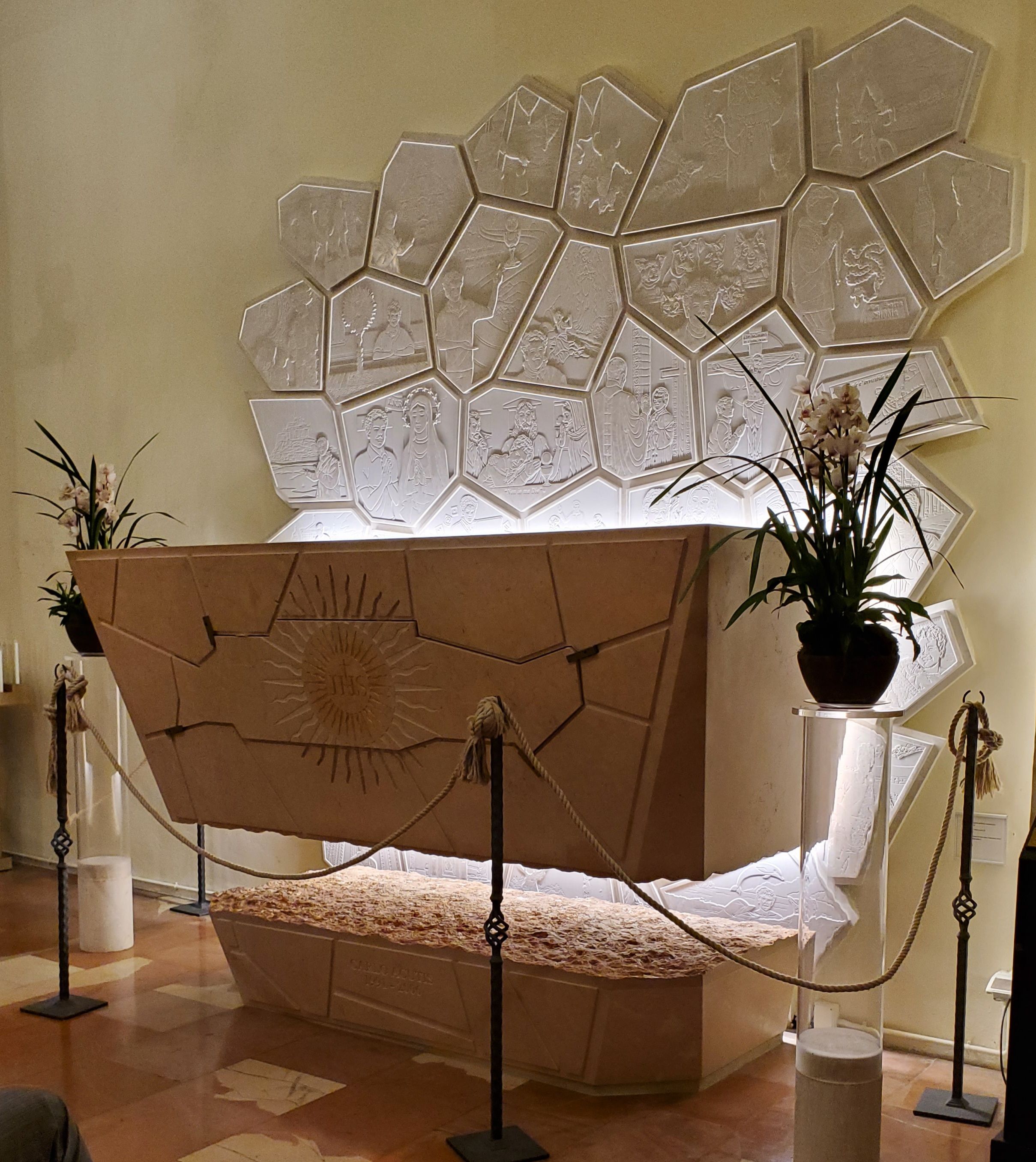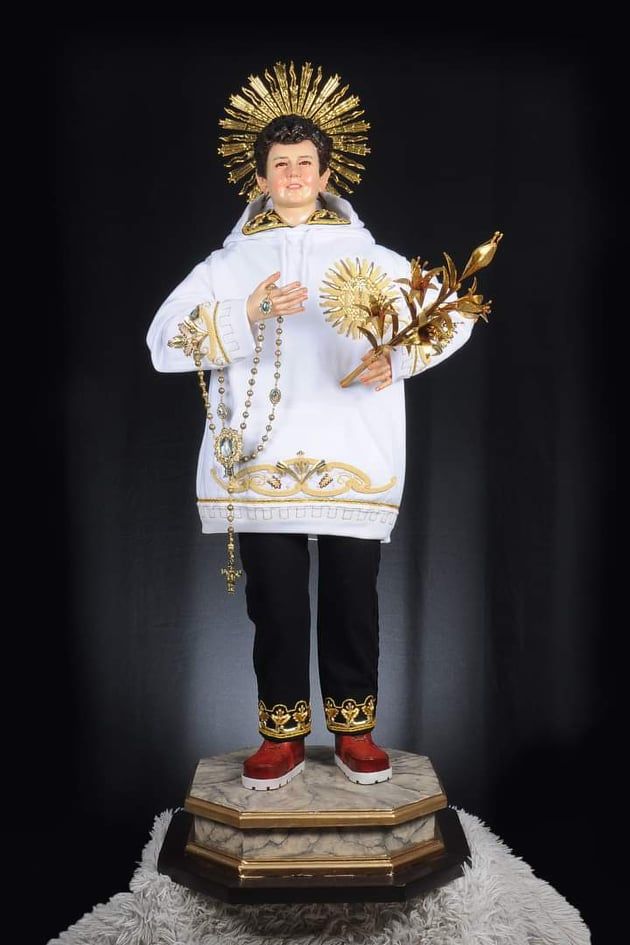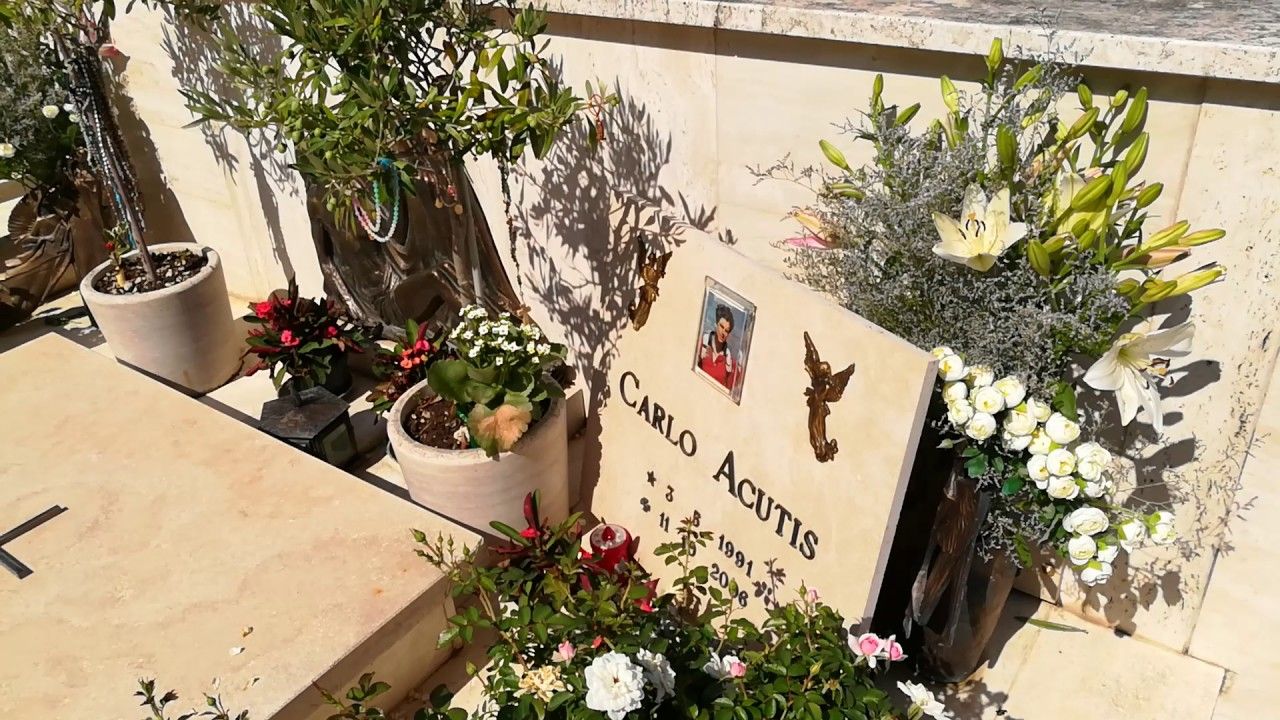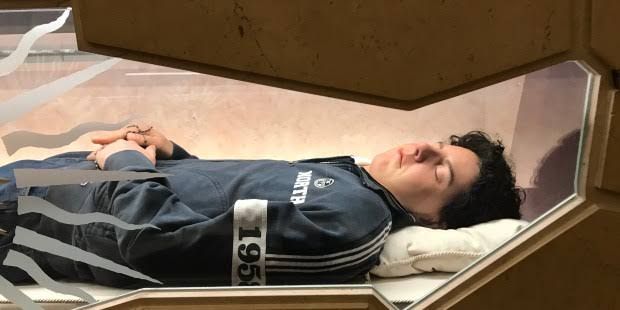He made the effort to go to daily Mass and to spend time in front of the Tabernacle in addition to weekly Confession. His high school studies were under the Jesuits at the Istituto Leone XIII.
He defended the rights of the disabled and defended disabled peers at school when bullies picked on them. He loved travelling but loved to visit Assisi more than other places. He had a passion for computers: everything including computer programming, film editing, website creation, editing and layout of comics, and volunteering for those most in need — children and the elderly.
He contracted Leukemia at a young age, and although he had requested that his parents take him on pilgrimages to the sites of all the known Eucharistic miracles in the world, his failing health prevented that.
Perhaps his most significant computer venture was cataloguing all the Eucharistic miracles of the world. He started the project when he was 11 years old and wrote at the time, “The more Eucharist we receive, the more we will become like Jesus, so that on this earth we will have a foretaste of Heaven.” He then asked his parents to start taking him to all the places of the Eucharistic miracles, and two and half years later the project was completed.
Acutis researched over “136 Eucharistic miracles that occurred over the centuries in different countries around the world, and have been acknowledged by the Church” and collected them into a virtual museum.
Besides creating a website to house this virtual museum, he helped create panel presentations that have traveled around the world. According to the introductory panel, “In the United States alone, thanks to assistance from the Knights of Columbus, The Cardinal Newman Society and The Real Presence Association and Education, with the support of Cardinal Edmond Burke, it has been hosted in thousands of parishes and more than 100 universities.” The panels have traveled to all five continents and have inspired many by their amazing photographs and beautiful stories.
To quote Carlo’s words:
"Our aim has to be the infinite and not the finite. The Infinite is our homeland. We have always been expected in Heaven." His famous quote is: "All people are born as originals but many die as photocopies."
To move towards this destination and not “die as photocopies” Carlo said that our compass has to be the Word of God, that we have to face constantly. But extreme means are required to reach such a lofty destination: the sacraments and prayer. In particular Carlo put the Sacrament of the Eucharist at the centre of his life and he called it "my highway to heaven".
He died from M3 fulminant leukemia on 12 October 2006 at the age of 15. He was buried in Assisi in accordance with his wishes.
He was declared Servant of God in 2016, not long after his death. On July 5, 2018 his cause progressed and he was named Venerable Carlo Acutis.
Some of his videos he produced are on YouTube under the channel name: "carloacutisbr"
His Facebook page is "CarloAcutisOAnjoDaJuventude"
His website is "miracolieucaristici.org"∼Reinterred at church of St Mary, Assisi, Itsly
A patron saint of the internet?
A 15-year-old boy who helped spread Roman Catholic teaching online is a good candidate to become patron saint of the internet, the Vatican says.
ROME — The good news for anyone praying for a little less online vitriol or a much faster internet connection is that the Vatican is on the case.
Showing that it has one foot in the 21st century, the ancient institution is backing a 15-year-old computer whiz to become the first patron saint of the internet.
Carlo Acutis, an Italian schoolboy who helped spread Roman Catholic teaching online before he died of leukemia in 2006, is the perfect candidate to become the protector of web surfers, said Cardinal Angelo Becciu, the head of the Vatican’s saint-making department.
“That’s my hope — he would be an ideal example for all young people,” said Becciu, whose official title is head of the Congregation for the Causes of Saints.
Carlo became deeply religious during his middle-class childhood in Milan and would donate his pocket money to the city’s poor residents.
Crucially, he used his prodigious coding talent to set up websites for priests. At the age of 10, he began to create an online exhibit about religious miracles, which has gained huge popularity since his death.
Business
Vatican social media guru: Catholics should give Internet 'a soul'
Hundreds of parishes around the world have printed off material from the site to create real-life exhibits of their own.
Last year, Pope Francis paid tribute to the teenager, declaring that his use of the internet to “communicate values and beauty” was the perfect antidote to the dangers of social media. In a document he wrote after a synod on youth, Francis quoted a phrase coined by Carlo warning other youngsters not to lose their individuality on the internet: “Everyone is born an original, but many die like photocopies.”
After citing the phrase, Francis added, “Don’t let this happen.”
As Carlo’s fame has spread, Catholics have started to pray to him, and in February, the pope attributed a miracle to the teen, triggering his beatification, the first step toward being made a saint. The beatification ceremony will be held Oct. 10 in the central Italian city of Assisi (of St. Francis fame).
World & Nation
Pope Francis adds new pathway to sainthood
The miracle in 2013 involved the rapid and inexplicable healing of a 6-year-old Brazilian boy suffering from a serious congenital deformation of the pancreas. A priest prayed to Carlo on the child’s behalf.
“The boy was vomiting and risked dying. Then, on the third day of prayers, he started eating,” said Antonia Salzano, Carlo’s mother, who works in publishing. His father works in the insurance business.
“We get news of miracles attributed to Carlo all the time,” said Salzano, 53. “One woman was cured of her cancer after attending his funeral, and I heard of two more a few days ago.”
She added that she could not fathom how Carlo’s fame had spread since his death. “It’s a mystery. I sense the finger of God,” she said. “Losing your son is the most terrible thing, but we are happy he is helping people discover their faith.”
World & Nation
John Paul II and John XXIII canonized as saints
Salzano recalled that Carlo had only “a very basic computer” but that he would study college textbooks to learn how to program and “saw the internet as a way to spread the faith.”
This month, Becciu told Vatican News that, when he was close to death, Carlo had said: “I want to offer all my suffering for the Lord, for the pope and for the church. I don't want to do purgatory; I want to go straight to heaven.”
The cardinal added: “He said that at 15! A little boy who talks like that strikes us, and I think it encourages everyone not to joke with our faith, but to take it seriously.”
To make it easier to pray at his tomb, the Vatican ordered Carlo’s body to be exhumed last year and reburied at the Shrine of Renunciation at the Church of St. Mary Major in Assisi.
World & Nation
Pope confers sainthood on Pope Paul VI and El Salvador's Oscar Romero
Further miracles attributed to prayers to Carlo will be studied by the Vatican. If it certifies a second miracle after Carlo’s beatification in October, the youth can be made a saint.
If that happens, Carlo would be a strong candidate to become patron saint of the internet, Becciu said, but “the pope decides.”
Declaring a patron saint for web surfers — actual surfers already have a protector out on the waves, St. Christopher — would be in keeping with the Vatican’s push to promote an online presence. The pope’s digital outreach efforts include his popular Twitter accounts, which boast more than 50 million followers, including 900,000 of his feed in Latin.
Catholic priests around the world turned to Zoom during coronavirus lockdowns to hold online services when churches were closed.
World & Nation
U.S. priest who founded Knights of Columbus to be beatified
Francis has described the internet as a “gift from God” but has also warned that hours spent alone online “can have the effect of isolating us from our neighbors, from those closest to us.” In 2016, he said nuns should be allowed to surf the internet in their convents but should not let online time become “occasions for wastingtime or escaping from the demands of fraternal life in community.”
If he declares Carlo the patron saint of the internet, Francis will probably cast the boy as a figure who can steer users away from loneliness and turn their surfing into a social, life-affirming experience.
In recent years, some reports have contended that the Catholic Church already has a patron saint of all things digital: Isidore, the 6th century bishop of Seville who created a 20-volume encyclopedia in a bid to put all knowledge in one place — a precursor of Google.
Press reports have said that Pope John Paul II declared him the saint of the web.
But Becciu said he could find no official record of Isidore being assigned the role by the Vatican. “There is nothing about that in the archives,” he said.
Salzano said her late son was ready to take on the responsibility, though it would be a heavy one.
“He will have to see all the ugly things on the internet. It will be a tough job, but a great way to spread faith,” she said. “I hope he can bring out the beautiful side of the net and fight the dark side.”
Must-read stories the L.A. Times
He made the effort to go to daily Mass and to spend time in front of the Tabernacle in addition to weekly Confession. His high school studies were under the Jesuits at the Istituto Leone XIII.
He defended the rights of the disabled and defended disabled peers at school when bullies picked on them. He loved travelling but loved to visit Assisi more than other places. He had a passion for computers: everything including computer programming, film editing, website creation, editing and layout of comics, and volunteering for those most in need — children and the elderly.
He contracted Leukemia at a young age, and although he had requested that his parents take him on pilgrimages to the sites of all the known Eucharistic miracles in the world, his failing health prevented that.
Perhaps his most significant computer venture was cataloguing all the Eucharistic miracles of the world. He started the project when he was 11 years old and wrote at the time, “The more Eucharist we receive, the more we will become like Jesus, so that on this earth we will have a foretaste of Heaven.” He then asked his parents to start taking him to all the places of the Eucharistic miracles, and two and half years later the project was completed.
Acutis researched over “136 Eucharistic miracles that occurred over the centuries in different countries around the world, and have been acknowledged by the Church” and collected them into a virtual museum.
Besides creating a website to house this virtual museum, he helped create panel presentations that have traveled around the world. According to the introductory panel, “In the United States alone, thanks to assistance from the Knights of Columbus, The Cardinal Newman Society and The Real Presence Association and Education, with the support of Cardinal Edmond Burke, it has been hosted in thousands of parishes and more than 100 universities.” The panels have traveled to all five continents and have inspired many by their amazing photographs and beautiful stories.
To quote Carlo’s words:
"Our aim has to be the infinite and not the finite. The Infinite is our homeland. We have always been expected in Heaven." His famous quote is: "All people are born as originals but many die as photocopies."
To move towards this destination and not “die as photocopies” Carlo said that our compass has to be the Word of God, that we have to face constantly. But extreme means are required to reach such a lofty destination: the sacraments and prayer. In particular Carlo put the Sacrament of the Eucharist at the centre of his life and he called it "my highway to heaven".
He died from M3 fulminant leukemia on 12 October 2006 at the age of 15. He was buried in Assisi in accordance with his wishes.
He was declared Servant of God in 2016, not long after his death. On July 5, 2018 his cause progressed and he was named Venerable Carlo Acutis.
Some of his videos he produced are on YouTube under the channel name: "carloacutisbr"
His Facebook page is "CarloAcutisOAnjoDaJuventude"
His website is "miracolieucaristici.org"∼Reinterred at church of St Mary, Assisi, Itsly
A patron saint of the internet?
A 15-year-old boy who helped spread Roman Catholic teaching online is a good candidate to become patron saint of the internet, the Vatican says.
ROME — The good news for anyone praying for a little less online vitriol or a much faster internet connection is that the Vatican is on the case.
Showing that it has one foot in the 21st century, the ancient institution is backing a 15-year-old computer whiz to become the first patron saint of the internet.
Carlo Acutis, an Italian schoolboy who helped spread Roman Catholic teaching online before he died of leukemia in 2006, is the perfect candidate to become the protector of web surfers, said Cardinal Angelo Becciu, the head of the Vatican’s saint-making department.
“That’s my hope — he would be an ideal example for all young people,” said Becciu, whose official title is head of the Congregation for the Causes of Saints.
Carlo became deeply religious during his middle-class childhood in Milan and would donate his pocket money to the city’s poor residents.
Crucially, he used his prodigious coding talent to set up websites for priests. At the age of 10, he began to create an online exhibit about religious miracles, which has gained huge popularity since his death.
Business
Vatican social media guru: Catholics should give Internet 'a soul'
Hundreds of parishes around the world have printed off material from the site to create real-life exhibits of their own.
Last year, Pope Francis paid tribute to the teenager, declaring that his use of the internet to “communicate values and beauty” was the perfect antidote to the dangers of social media. In a document he wrote after a synod on youth, Francis quoted a phrase coined by Carlo warning other youngsters not to lose their individuality on the internet: “Everyone is born an original, but many die like photocopies.”
After citing the phrase, Francis added, “Don’t let this happen.”
As Carlo’s fame has spread, Catholics have started to pray to him, and in February, the pope attributed a miracle to the teen, triggering his beatification, the first step toward being made a saint. The beatification ceremony will be held Oct. 10 in the central Italian city of Assisi (of St. Francis fame).
World & Nation
Pope Francis adds new pathway to sainthood
The miracle in 2013 involved the rapid and inexplicable healing of a 6-year-old Brazilian boy suffering from a serious congenital deformation of the pancreas. A priest prayed to Carlo on the child’s behalf.
“The boy was vomiting and risked dying. Then, on the third day of prayers, he started eating,” said Antonia Salzano, Carlo’s mother, who works in publishing. His father works in the insurance business.
“We get news of miracles attributed to Carlo all the time,” said Salzano, 53. “One woman was cured of her cancer after attending his funeral, and I heard of two more a few days ago.”
She added that she could not fathom how Carlo’s fame had spread since his death. “It’s a mystery. I sense the finger of God,” she said. “Losing your son is the most terrible thing, but we are happy he is helping people discover their faith.”
World & Nation
John Paul II and John XXIII canonized as saints
Salzano recalled that Carlo had only “a very basic computer” but that he would study college textbooks to learn how to program and “saw the internet as a way to spread the faith.”
This month, Becciu told Vatican News that, when he was close to death, Carlo had said: “I want to offer all my suffering for the Lord, for the pope and for the church. I don't want to do purgatory; I want to go straight to heaven.”
The cardinal added: “He said that at 15! A little boy who talks like that strikes us, and I think it encourages everyone not to joke with our faith, but to take it seriously.”
To make it easier to pray at his tomb, the Vatican ordered Carlo’s body to be exhumed last year and reburied at the Shrine of Renunciation at the Church of St. Mary Major in Assisi.
World & Nation
Pope confers sainthood on Pope Paul VI and El Salvador's Oscar Romero
Further miracles attributed to prayers to Carlo will be studied by the Vatican. If it certifies a second miracle after Carlo’s beatification in October, the youth can be made a saint.
If that happens, Carlo would be a strong candidate to become patron saint of the internet, Becciu said, but “the pope decides.”
Declaring a patron saint for web surfers — actual surfers already have a protector out on the waves, St. Christopher — would be in keeping with the Vatican’s push to promote an online presence. The pope’s digital outreach efforts include his popular Twitter accounts, which boast more than 50 million followers, including 900,000 of his feed in Latin.
Catholic priests around the world turned to Zoom during coronavirus lockdowns to hold online services when churches were closed.
World & Nation
U.S. priest who founded Knights of Columbus to be beatified
Francis has described the internet as a “gift from God” but has also warned that hours spent alone online “can have the effect of isolating us from our neighbors, from those closest to us.” In 2016, he said nuns should be allowed to surf the internet in their convents but should not let online time become “occasions for wastingtime or escaping from the demands of fraternal life in community.”
If he declares Carlo the patron saint of the internet, Francis will probably cast the boy as a figure who can steer users away from loneliness and turn their surfing into a social, life-affirming experience.
In recent years, some reports have contended that the Catholic Church already has a patron saint of all things digital: Isidore, the 6th century bishop of Seville who created a 20-volume encyclopedia in a bid to put all knowledge in one place — a precursor of Google.
Press reports have said that Pope John Paul II declared him the saint of the web.
But Becciu said he could find no official record of Isidore being assigned the role by the Vatican. “There is nothing about that in the archives,” he said.
Salzano said her late son was ready to take on the responsibility, though it would be a heavy one.
“He will have to see all the ugly things on the internet. It will be a tough job, but a great way to spread faith,” she said. “I hope he can bring out the beautiful side of the net and fight the dark side.”
Must-read stories the L.A. Times
